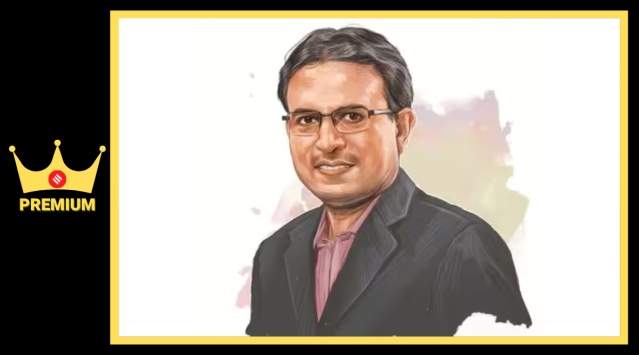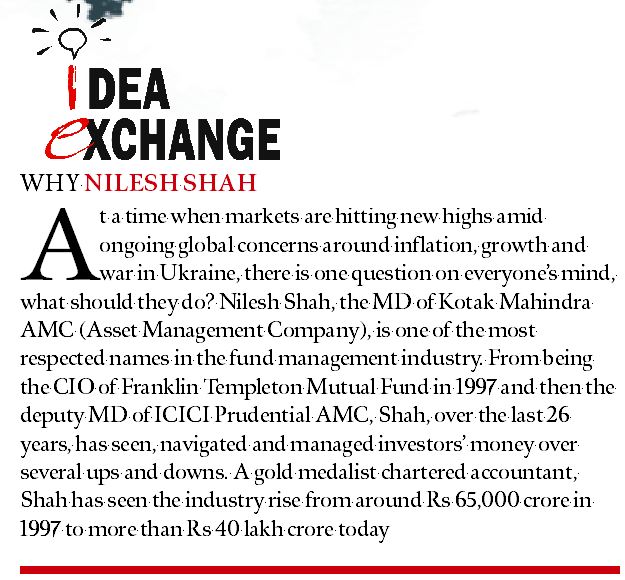Nilesh Shah: ‘This is India’s time. There is assurance that this journey is likely to not falter’
At a time when markets are hitting new highs amid ongoing global concerns around inflation, growth and war in Ukraine, there is one question on everyone’s mind, what should they do?
 Nilesh Shah, Managing Director, Kotak Mahindra AMC
Nilesh Shah, Managing Director, Kotak Mahindra AMC In this Idea Exchange, Nilesh Shah, Managing Director, Kotak Mahindra AMC, talks about the rising markets in the wake of global inflation, sustainability of this growth in the long term and evolution in the profile of the retail investor. The session was moderated by Sandeep Singh, Resident Editor, Mumbai
Sandeep Singh: What is happening in the market and where is it headed?
Our economy is progressing but our peer group’s economy has started going down. Hence, we look much better and brighter. Look at our competition. Russia — no foreigner will go and invest there; China — it is undoubtedly cheaper but everyone is worried that in this country one does not know of the foreign minister, so what will happen to one’s money; South Africa — there are 12-hour power cuts. Brazil — a very open communist agenda; Turkey — the currency keeps falling faster than you can pronounce Turkey. If you are a global investor, where can you put your money to work? Others have underperformed so badly, that we are now looking far better and brighter. It’s always about relativeness. Secondly, because there is economic confidence, flows are coming from domestic mutual fund buyers, domestic retail, High Networth Individuals (HNIs), and foreign portfolio investors and buyers. There is aggressive buying and it is this combination of long-term fundamentals and flows which is driving the market higher.
Sandeep Singh: Retail money has been coming in hope of good returns. What arguments justify those hopes?
There’s dignity in our economic numbers. India was the fastest-growing major economy last year, is this year too and probably next year. The world over, people are fighting high inflation. We are one of the rare countries that has real positive interest rates and inflation below RBI’s target range. In case of forex reserves, we are at $600 billion-plus. Our oil prices, thanks to the Russia-Ukraine war, were supposed to be in three digits plus but are in two digits. Geopolitically, India is a beneficiary because it buys cheaper oil from Russia and jet engine technology from America. Both want to woo us. We had a trade deficit problem till December 2022, numbers were in excess of $25-$30 billion a month. The balance of payment for January-February-March was just a quarter billion dollars. This is the first time in 60 years that Mumbai and Delhi got monsoon at the same time. In Mumbai, it was delayed by 20 days but everything recovered with the highest-ever rains in July. We were always a less productive and less competitive nation. Now we are improving in both. The infrastructure creation story in India is one of the most underrated stories. Highways, ports, airports, railway electrification, coal mining and power production — what we did in 67 years from 1947 to 2013, we are replicating in 10 years from 2014 to 2024, allowing us to grow faster.

P Vaidyanathan Iyer: Is this growth sustainable in the long term? Post the pandemic, the consumer goods growth in rural India has worsened. A stock market will always do well. But does that part of India concern you?
Our weak point and cause of worry is the uneven recovery. The lower-middle class and poor people have not benefited as much from this growth as the rich and the upper-middle class. For one-and-a-half years, India’s listed FMCG company didn’t show volume growth in consumer staples. In those six quarters, urban consumption was negative for a while and then became marginally positive. Secondly, there were contradictory signals. Tourism and travel was at its peak and hotel rooms were not available. And yet, there was a 29 per cent drop in the non-suburban railway traffic. What explains that, especially when tourism is at its peak? We saw a reduction in two-wheelers sales. Whether it is in ordering food via Zomato or sharing UPI payments, clearly, a small minority contributes majorly on value terms. There is no denial that the bottom half of the pyramid hasn’t participated in the growth story, especially post-COVID. There are signs of revival — rural FMCG volume growth for June 2023 quarter has turned positive, monsoon has come out reasonably well. Overall, it bodes well for a rabi crop, if not for kharif crop. That will have its own positive momentum in the rural economy. Private capital expenditure, which was on the back foot, seems to be bottoming out and we are seeing more announcements coming from the private sector. We are hopeful that with their balance sheet deleveraged, it should translate into action on ground. Government spending is in full swing. While post-COVID, the bottom half of the pyramid has suffered, there is expectation that from here onwards we’ll probably see positive volume growth.
If you are a global investor, where can you put your money to work? Others have underperformed so badly, that we are now looking far better and brighter. It’s always about relativeness
Story continues below this ad
P Vaidyanathan Iyer: Till a month or two ago, we were hearing that corporate boards are still not getting investment proposals. What do you hear now in capital-intensive job-creating sectors?
There is a sharp increase in announcements of capital plans. Every company is looking to expand capacity. But many times you speak for the market rather than reality on the ground. But today are we fundamentally in a better position to see a revival of capital expenditure? Yes. Companies’ balance sheets are deleveraged. Credit is there as there is excess liquidity in the banking system and banks have higher capitalisation to lend. Third, equity markets are buoyant. If you want to raise capital, it will be available as long as you have a good business and you offer it at a reasonable valuation. Your capacity utilisation is reaching a 75 per cent plus level, so there is an incentive to expand capacity. There are certain segments like electronic components and technical fibres where you can become part of the global supply chain thanks to ‘China Plus One’. In defence, where thanks to the government policy of encouraging domestic manufacturers, people may look to expand. So we are seeing a bottoming out of the private capital expenditure cycle. Now, announcements will get converted into action as a combination of availability of debt, equity, utilisation of credit and deleveraged balance sheets.
P Vaidyanathan Iyer: Everybody tells retail investors that it’s better to enter through mutual funds. But in the last quarter, even in mutual funds, the net inflows have come down sharply. What are the downside risks to the market?
Retail investors have matured a lot. There was a time when they would come after the markets had moved higher and they’d make the top of the market like we saw in the 1992, 2000 and 2008 cycle. But the 2020 and 2023 retail investors are a different lot. From October 2021 to June 2022, FPIs sold Rs 2,50,000 crore of equity and retail bought them out. Now retail investors are doing profit booking. There are many countries where when markets go down they say you can’t sell on a downtick, but on an uptick. People juxtapose these things with India. Not only do we give you an exit, we return your money. This gives immense confidence to foreigners that India is a market with entry as well as exit.
Retail investors have matured a lot. There was a time when they would come after the markets had moved higher and they’d make the top of the market. Now retail investors are doing profit booking
Story continues below this ad
George Mathew: The corporate performance in the second quarter was not great. Is this market rally based on fundamentals?
Mutual funds have created a beautiful product called balance advantage fund and asset allocation fund. The combined size of these funds will be about Rs 2,50,000 crore. In this, we buy when markets are cheap and sell when expensive. If there is a 30 to 40 per cent delta, it means there will be a movement of Rs 75,000 crore in the balance advantage fund alone in terms of equity allocation. As markets have risen, the balance advantage fund has started doing profit booking, which is why you see as if mutual funds are selling. In our active fund, other than the balance advantage fund, we have received net flows and we are net buyers. When you see the net number, on many days it is negative. The current market rally is partly because there is no alternative and hence our line is looking brighter than others. But this is also driven by hope for India’s economy. Everyone believes this is India’s time. There is assurance that this journey is likely to continue and not falter like it did in Russia, South Africa and may happen in China. Which is why this rally is driven by flows but anchored by fundamentals.
Siddhant Mishra: What justifies people’s faith in SIPs even when retail inflows have shown a shaky trend?
People now have positive experiences of the last 30 years. Today, most parents who were or are mutual fund investors will tell their children to start a SIP. We have moved from being an exotic product for rich HNIs in urban or metropolitan India to everyone’s house. Most rural households do not get money or liquidity as quickly as mutual funds. There is the power of compounding.
Siddhant Mishra: How do you see BlackRock’s re-entry into India with its partnership with Jio? Also, what makes the Indian mutual fund industry difficult for foreign players to survive?
BlackRock’s return is a sign of confidence. The world’s largest manager comes back to India with a formidable partner like Jio. Most foreign mutual funds which came to India didn’t become Indian companies. They wanted to apply their ways of doing business. If you behave arrogantly, you’re bound to fail in India. A lot of foreign mutual funds probably didn’t understand the intricacies of doing business. It’s a growing market, but not an easy market.
Anil Sasi: What about the element of FOMO (fear of missing out) in this current market rally?
There is FOMO but it is with global investors not with local investors. The latter bought heavily when FPIs were selling in March 2020, as well as from October 2021 to June 2022. Foreigners are feeling left out that India is such a great story and we are neutral weight and not overweight. When people look at our performance vis-a-vis our peer group, we are expensive from a valuation point of view. The combination of 3Gs — growth, governance and green — excites people and that creates FOMO among global investors. Is the rally driven right now by flows? Yes. But is the market looking horribly expensive? No. It is marginally above its fair value.
Rahul Sabharwal: We’ve seen some small-cap funds performing upwards of 40 per cent in a year. What do you make of some mutual funds closing in flows? Do you think that is a segment of the market that might be more overheated than others?
The micro cap and mini cap look horribly expensive. Small caps look a little expensive compared to mid and large cap. There are funds which are lump sum subscriptions in small cap. But right now, the number crunching does not suggest that they are horribly expensive. They are trading at above average valuation. Last month we said that you should be booking profits in the rally in small and mid cap and try to move to large, or large and mid cap fund. In this market, this is not the valuation where you should be overweight equity, you should be neutral weight equity. And please take a longer term call. Inevitably, despite our growth story, there will always be a correction in the market.
Sandeep Singh: The Federal Reserve went for a hike and India has taken a pause. Do you subscribe to the RBIs current stance? Do you think India’s inflation worries are over?
The RBI is God’s gift to India. At one point, we had a liquidity of Rs nine lakh crore. They brought it down to one lakh crore before it could feed into inflation. Now again liquidity has gone back, thanks to the Rs 2000 note coming back. That number is probably four lakh crore. But they’re managing liquidity far more proactively than what the US Fed. The US Fed continued expanding their balance sheet and reached a peak of $9 trillion. In liquidity takeout, RBI set an example for the rest of the world to follow. They were proactive in raising interest rates. And now they have the luxury of remaining on hold. The next month’s inflation number will probably be around six per cent because of tomato prices. But as fresh crop comes in, prices will come down. Ahead of the state election, could there be a reduction in oil prices? That could set the stage for lowering of energy prices, thus bringing down inflation.
Sukalp Sharma: In the Indian markets, what is an ideal mix between FIIs, DIIs and retail investors? Are we there yet?
The bread is buttered on the same side for domestic investors as well as global investors. We are not in competition. If market capitalisation goes up, if companies do well, we both benefit. FPIs are here to make money, they’re putting money because they believe India will deliver better returns. What we have to actually create is a thriving vibrant market. As long as markets are vibrant, flows can come and match.
Hitesh Vyas: Do you think this rise in inflation because of the current surge in food prices will delay RBI rate cut?
If you are RBI, would you like to do a rate cut ahead of the Fed? Unlikely. I think unless the Indian inflation number drops so dramatically, or growth suffers so heavily, both are very low probability scenarios, RBI would like the Fed to move first and then take a call.
Anil Sasi: The stock market reflects the fortunes of the top 100-200 big companies better placed and have access to funds. But how sustainable is this given that the MSMEs give the corporate sector a certain cost advantage as suppliers or competitors?
If you have to compete in the world, or even in India, we need economies of scale. That’s possible only in large companies. That doesn’t mean we have to kill our small and medium enterprises. But at the same time, we also have to ensure that they don’t become a drag by becoming uncompetitive, they don’t rely on subsidised electricity bills and power taps to reduce their power cost. If we can bring together productivity, scale benefits, then we will become competitive. MSMEs will have to become part of an organised sector. They’ll probably become a tier supplier to large companies, like Maruti created a huge auto component industry. And this transition will be painful. But if we don’t do this transition, then we’ll remain like we were between the 1950s and 1990. Everyone will outperform us.
Sandeep Singh: What is your advice to investors, especially for the new people coming into the job cycle?
Everyone should start in SIP. Now, whether you start in one large cap, mid cap or one small cap fund that is your choice, but please have a SIP so that you have a habit of regular investing. Second, if you can’t do asset allocation, then please invest in funds like asset location fund, where the fund manager is doing it. As for return expectation. I think our inflation will remain in the low single digit. We can expect high single digit or low double digit return.
Photos
- 01
- 02
- 03
- 04
- 05































